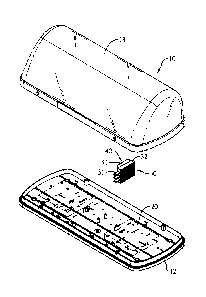Une partie des informations de ce site Web a été fournie par des sources externes. Le gouvernement du Canada n'assume aucune responsabilité concernant la précision, l'actualité ou la fiabilité des informations fournies par les sources externes. Les utilisateurs qui désirent employer cette information devraient consulter directement la source des informations. Le contenu fourni par les sources externes n'est pas assujetti aux exigences sur les langues officielles, la protection des renseignements personnels et l'accessibilité.
L'apparition de différences dans le texte et l'image des Revendications et de l'Abrégé dépend du moment auquel le document est publié. Les textes des Revendications et de l'Abrégé sont affichés :
| (12) Demande de brevet: | (11) CA 3098173 |
|---|---|
| (54) Titre français: | VOYANT D'AVERTISSEMENT |
| (54) Titre anglais: | WARNING LIGHT |
| Statut: | Réputée abandonnée et au-delà du délai pour le rétablissement - en attente de la réponse à l’avis de communication rejetée |
| (51) Classification internationale des brevets (CIB): |
|
|---|---|
| (72) Inventeurs : |
|
| (73) Titulaires : |
|
| (71) Demandeurs : |
|
| (74) Agent: | ADE & COMPANY INC. |
| (74) Co-agent: | |
| (45) Délivré: | |
| (22) Date de dépôt: | 2020-11-05 |
| (41) Mise à la disponibilité du public: | 2022-05-05 |
| Requête d'examen: | 2020-11-05 |
| Licence disponible: | S.O. |
| Cédé au domaine public: | S.O. |
| (25) Langue des documents déposés: | Anglais |
| Traité de coopération en matière de brevets (PCT): | Non |
|---|
| (30) Données de priorité de la demande: | S.O. |
|---|
A waming light has a shell (10), a light-emitting device (20), a heating
device (30), and an assisted diversion member (40). The shell (10) has a
chamber (11) formed in the shell (10). The light-emitting device (20) and the
heating device (30) are mounted in the shell (10) and are located in the
chamber (11) of the shell (10). Air in the chamber (11) absorbs heat energy
generated by the heating device (30). The assisted diversion member (40) is
mounted into the chamber (11) of the shell (10) and is located beside the
heating device (30). The assisted diversion member (40) assists the air
absorbing the heating energy in the chamber (11) to flow in the chamber (11).
The heating device (30) and the assisted diversion member (40) co-work to
heat the shell (10) evenly for effectively removing snow accumulated on the
shell (10).
Note : Les revendications sont présentées dans la langue officielle dans laquelle elles ont été soumises.
Note : Les descriptions sont présentées dans la langue officielle dans laquelle elles ont été soumises.

2024-08-01 : Dans le cadre de la transition vers les Brevets de nouvelle génération (BNG), la base de données sur les brevets canadiens (BDBC) contient désormais un Historique d'événement plus détaillé, qui reproduit le Journal des événements de notre nouvelle solution interne.
Veuillez noter que les événements débutant par « Inactive : » se réfèrent à des événements qui ne sont plus utilisés dans notre nouvelle solution interne.
Pour une meilleure compréhension de l'état de la demande ou brevet qui figure sur cette page, la rubrique Mise en garde , et les descriptions de Brevet , Historique d'événement , Taxes périodiques et Historique des paiements devraient être consultées.
| Description | Date |
|---|---|
| Inactive : Morte - Aucune rép à dem par.86(2) Règles | 2023-05-24 |
| Demande non rétablie avant l'échéance | 2023-05-24 |
| Réputée abandonnée - omission de répondre à un avis sur les taxes pour le maintien en état | 2023-05-08 |
| Lettre envoyée | 2022-11-07 |
| Réputée abandonnée - omission de répondre à une demande de l'examinateur | 2022-05-24 |
| Demande publiée (accessible au public) | 2022-05-05 |
| Inactive : Page couverture publiée | 2022-05-04 |
| Rapport d'examen | 2022-01-21 |
| Inactive : Rapport - Aucun CQ | 2022-01-20 |
| Représentant commun nommé | 2021-11-13 |
| Inactive : CIB attribuée | 2020-11-26 |
| Inactive : CIB attribuée | 2020-11-26 |
| Inactive : CIB attribuée | 2020-11-26 |
| Inactive : CIB en 1re position | 2020-11-26 |
| Lettre envoyée | 2020-11-23 |
| Exigences de dépôt - jugé conforme | 2020-11-23 |
| Lettre envoyée | 2020-11-20 |
| Déclaration du statut de petite entité jugée conforme | 2020-11-05 |
| Demande reçue - nationale ordinaire | 2020-11-05 |
| Inactive : CQ images - Numérisation | 2020-11-05 |
| Représentant commun nommé | 2020-11-05 |
| Exigences pour une requête d'examen - jugée conforme | 2020-11-05 |
| Toutes les exigences pour l'examen - jugée conforme | 2020-11-05 |
| Date d'abandonnement | Raison | Date de rétablissement |
|---|---|---|
| 2023-05-08 | ||
| 2022-05-24 |
| Type de taxes | Anniversaire | Échéance | Date payée |
|---|---|---|---|
| Taxe pour le dépôt - petite | 2020-11-05 | 2020-11-05 | |
| Requête d'examen - petite | 2024-11-05 | 2020-11-05 |
Les titulaires actuels et antérieures au dossier sont affichés en ordre alphabétique.
| Titulaires actuels au dossier |
|---|
| NENG-CHEN YEH |
| Titulaires antérieures au dossier |
|---|
| S.O. |